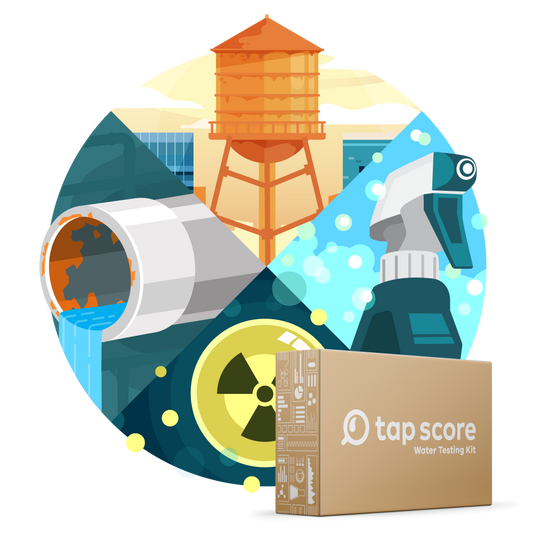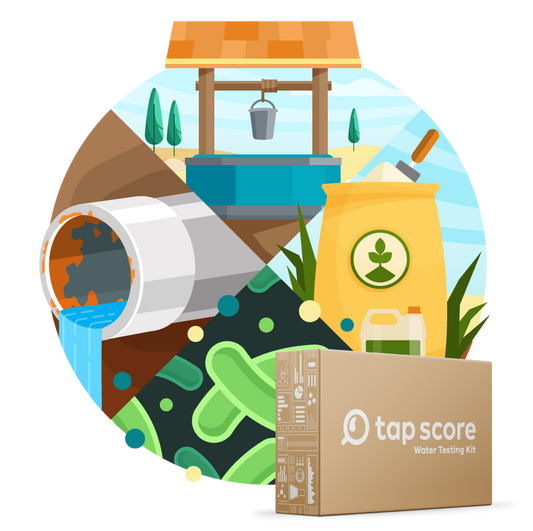
Lab Tests vs. Test Strips: What’s the Best Home Water Test in 2025?
Our blog is written by real experts— not AI. Each guide is carefully reviewed and updated based on the latest research. Plus, with no affiliate links, you can count on unbiased insights you can trust.
As water infrastructure ages, drinking water analysis is becoming increasingly important. But with the market flooded by so many different packaged drinking water tests, how do you determine what the best home water quality test is for you?
This guide offers a breakdown of home water tests for everyday consumers.
Table of Contents:
- What Are the Most Popular Home Water Tests?
- What to Look for in a Home Water Test
- Top Tips Before Buying Home Water Tests Online
- What’s the Takeaway?
What Are the Most Popular Home Water Tests?
There are two primary home water quality testing options available today:
- DIY or Home Water Tests
- Mail-to-laboratory Water Tests
Do-it-yourself, home water tests remain very popular thanks to their low cost and instant results. You can find dozens of them for sale on Amazon and at every home improvement store.
Lab water testing kits are more expensive and require a several day wait for results. But those results are considerably more precise and have higher accuracy at low concentrations.
While both DIY and mail-to-lab options will provide you with information about your water, the cost, range and precision of results vary widely.
Why Do People Test Their Water?
DIY Home Water Tests

Image credit: Canva
The vast majority of do-it-yourself water tests feature chemical strips that change color depending on the amount of a particular contaminant present in the water sample.
Common Water Test Strips Include:
- Water hardness test strips
- Test strips for water pH and alkalinity
- Iron and copper test strips
- Free and total chlorine test strips
After dipping the strip into your water sample and waiting the specified time, the strip’s color is compared to a color chart included in the test box. By comparing your test strip to the color chart you can deduce the approximate level of a particular contaminant or parameter.

Home water tests can also refer to color disk kits and TDS meters.
-
Color disk kits consist of a sample vial which you fill with water and then add either a powder or a few droplets of a liquid reagent. The water will then change color depending on the contaminants present in the water sample. Just like test strips, the sample color is compared to a color gradient disk included in the kit. While these are considered to be slightly more precise than dip strips due to the use of reagents and more detailed color gradients, their limitations are of the same nature.
- TDS meters are small digital meters that are dipped into a water sample to provide a reading of the sample’s TDS, or total dissolved solids. We’ve written about TDS in water in more detail, but to sum up: Neither high nor low TDS is an indicator of water quality because it’s only one parameter among the many that contribute to overall water quality. Filtration companies typically pitch high TDS as a cause for alarm, but a high TDS reading (>500 PPM) does not indicate the presence of any specific contaminants, harmful or not. It may be that harmful contaminants are present, but you cannot know this from a TDS meter alone.

When Should I Use DIY Home Water Tests?
Home test strips and kits are particularly helpful for:
- pH level (used to determine the acidity or basicity of a fluid)
- Free Chlorine (the amount of chlorine yet to combine with chlorinated water to effectively sanitize contaminants)
- Total Dissolved Solids (TDS) (Total organic and inorganic compounds in water)
- Screening for bacteria like coliform, pseudomonads, and other iron-related bacteria. (Screens may be less accurate than laboratory testing but—if done carefully—can be a valuable part of a responsible bacterial monitoring program.)
Pros of Test Strips:
- Affordability (Most can be purchased for $50)
- Rapid results
- Work best for pH, Free Chlorine and H2S (Hydrogen sulfide or “swamp gas”); good for hardness
For the vast majority of common water concerns like lead, PFAS, VOCs, and pesticides, professional laboratory analysis offers the recommended level of precision and accuracy.
Cons of Test Strips:
- Very limited range of contaminants you can test for (does not test for pesticides, VOCs, PFAS, etc.)
- Won’t help you if toxic compounds present at low concentrations
- High margin of error and low accuracy—especially at low concentrations
- Customers often report that instructions are confusing and color gradients hard to decipher
Bottom Line: If you want instant results for simple concerns, water test strips are an affordable do-it-yourself option.
Mail-to-Lab Testing Kits

Image credit: Shutterstock
Laboratory water test kits offer you a much wider range of contaminants you can test for paired with increased precision, accuracy and quality control. Typically, your purchase includes a sampling kit with
- A set of materials and detailed instructions for collecting samples,
- A prepaid return shipping label to mail your sample to the lab.*
Several days after the laboratory receives your kit, you will receive a rigorous analysis, or lab report, emailed directly to you.
*Note: Pay attention to whether or not your laboratory test kit includes shipping both ways. Some do not, leaving you with shipping costs that could be steep. Tap Score’s award-winning mail-to-laboratory test kits always include free shipping both ways.
Pros of Lab Tests:
- Comprehensive (test for thousands of chemicals and microbes)
- Highly customizable to meet specific needs
- Easy-to-follow instructions
- Certified lab professionals and instrumentation give your results cutting-edge accuracy, precision, detail
- Results are more reliable because labs adhere to rigorous quality control standards to meet their certifications
Additionally, laboratory testing can be tailored to your water supply: City water testing, well water testing, rainwater or spring water testing all have different needs. Laboratories have the equipment and expertise necessary to analyze on case-by-case bases.
Cons of Lab Tests:
- Less affordable than test strips (Costs increase as the number and type of contaminants increase. It’s helpful to do some homework before you purchase)
- Longer to get results (Some labs work faster than others)
Bottom Line: Lab test kits allow you to test for thousands of specific contaminants with cutting edge accuracy, precision, and detail, but they are more expensive and results will take a bit longer.
Remember: Water tests are snapshots in time. Keeping an eye on changes in your local water supply, as well as routine maintenance and upkeep on any and all water treatment systems are all just as important as testing. Learn more:
The Ultimate Guide to Well Owner Maintenance
The Best Water Test Kits for New Homeowners
Renters' Quick Guide to Water Testing & Filtration
What to Look for in a Home Water Test Kit
Whatever you’re testing for, your number one goal should be accuracy and precision. Depending on what you want to test for, each variety of test has its virtues and its limitations.
- If you're looking to evaluate health risks or plumbing risks, lab testing through mail-to-lab test kits are the way to go.
- If you're looking to understand your ph, H2S, or chlorine levels, test strips can be very practical solutions.
Make sure your kit contains everything you need to test properly—including detailed destructions. For example, TDS meters tend to run on batteries, color disks require reagents.

Mail-to-Lab Kits
Before ordering a mail-to-lab home water analysis test kit, make sure it includes:
- Vials and containers for water sampling
- Instructions for use
- Ice packs to retain sample integrity
- Shipping labels
- Chain of custody and/or sampling information documentation.
After you order and receive your sampling kit, follow the collection instructions carefully and ship your samples to the lab. Expect to wait 3-10 days (depending on the lab and panel) for results.*
*Note: Tap Score offers RUSH sampling for a select suite of contaminants. Helpful for those dealing with unforeseen or unexpected events.
5 Tips Before You Buy A Water Test Online
There are different types of water tests and water quality reports available online. Unfortunately, not everything you’ll find is accurate, and claims can often be widely misleading. We’ve compiled a quick list of things to look out for before you buy:
- Most do-it-yourself or at-home test kits are neither very accurate nor comprehensive. Too many of these products exaggerate what they’re able to provide for you. (e.g. “Test for Hundreds of Contaminants!”, “Test for Everything!”) If you have any concern beyond the parameters we covered above, you’re much better off letting laboratory professionals perform the full analysis for you.
- Never accept “Free tests” offered by a water treatment company. While some treatment companies will facilitate access to a certified testing laboratory for their customers, a staggering amount of companies will still try to give you a “free” water test in your kitchen. These are almost always a rigged test to pressure you into buying a treatment system you can’t be certain you even need.
- No DIY sampling method will be fully certified for loan compliance. If you need a water test for a home loan, a do-it-yourself home test will not be enough. Any on-site test that does not utilize laboratory analysis but claims it is completely “certified” for VA/USDA/FHA loan compliance should warrant triple-checking with your loan officer. In many cases, obtaining a fully certified sample requires a state-authorized operator to perform the sample collection and transport it for you. Be sure to refer to your loan’s unique requirements to determine whether or not you need a third party to collect your sample.
- Keep an eye on shipping costs. Many labs will exclude the expensive cost of return shipping when they sell a testing service. Sending a heavy, water-filled package to a lab quickly (especially for testing bacteria) can cost you $100+. Look out for testing services that don’t include disposal fees or shipping fees.
- More contaminants does not mean better testing. Some companies will try to sell you on kits that list a huge number of detectable contaminants. This is nothing more than a marketing spin. Any lab can readily perform certain testing methods that will concurrently analyze water for hundreds of superfluous chemicals. More often than not, these chemicals have no realistic chance of appearing in your drinking water.
Tap Score simplifies this process for you, connecting you with a nationwide network of certified laboratories to give you the widest range of testing capabilities customized to suit your needs. Here are some of our best lab water tests:
What’s the Takeaway?
- No matter where you live or where you source it, testing your water is always a good move. The more you know, the better you’ll feel about trusting your tap.
- While at-home water testing strips and color disk kits are easy to use and affordable, they’re really only useful when it comes to simple checks: like pH, chlorine, or TDS levels.
- Mail-to-lab water testing is the best home water analysis kit available. Reports produced by laboratory testing are highly accurate, precise and comprehensive
- When it comes to shopping for home water tests, keep an eye out for exaggerated claims and hidden costs—if it sounds too good to be true, it usually is!










